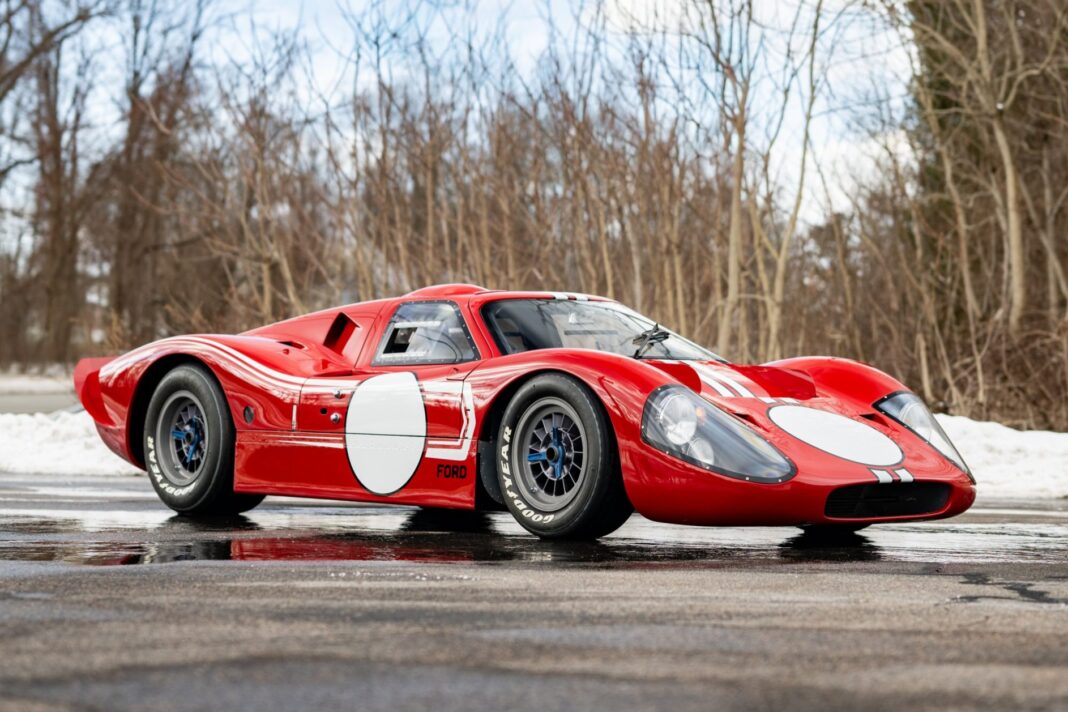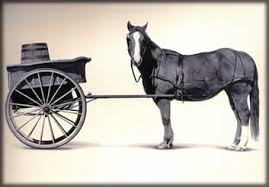This 1967 Ford GT40 is one of 12 J-car chassis constructed by Kar Kraft in Detroit and is among two that were adapted for Group 7 competition with spyder bodywork after FIA prototype rule changes precluded Ford’s use of the Mark IV in international racing. Referred to as the G7A, chassis J-10 was sold as part of a two-car package in early 1969 to Charles and Kerry Agapiou, who campaigned it in Can-Am competition over the ensuing two seasons, during which it placed second in the Fuji 200 miles for its lone finish in 10 starts. Following a crash at the end of the 1970 season, the car was sent to England for repairs and was set aside for several years before being sold in 1989 to a Los Angeles real estate developer who initiated a conversion to a Mark IV-style configuration. It was then sold as an unfinished project in 1996 to its current owners, who completed a four-year refurbishment in 2017 before debuting the car at the 2018 Amelia Island Concours d’Elegance. Finished in a red livery replicating that of the 1967 Le Mans-winning GT40, the car is powered by a 427ci Ford FE V8 that breathes through twin Holley four-barrel carburetors and is mated to a Kar Kraft T-44 four-speed manual transaxle. Additional features include four-wheel ventilated disc brakes, independent suspension with coilover shock absorbers, staggered-width 15” turbine-style center-lock magnesium alloy wheels, “bundle of snakes” exhaust headers, dual electric cooling fans, a steel roll cage, a driver’s seat upholstered in black cloth, and a dimpled passenger seat. J-10 is now offered on dealer consignment in Portland, Connecticut, with historical correspondence and a bill of sale.
Development of the J-car began in fall 1965 as Ford set out to create a lighter, more aerodynamic successor to the soon-to-be-Le Mans-winning GT40 Mark II while taking advantage of upcoming changes to Appendix J of FIA regulations. While the Mark II cars were constructed in England, the J-car was constructed by Ford subsidiary Kar Kraft in the US on a chassis consisting of aluminum honeycomb sandwich panels bonded together with heat-cured structural adhesives that were designed in partnership with the military defense division of the Brunswick Corporation.
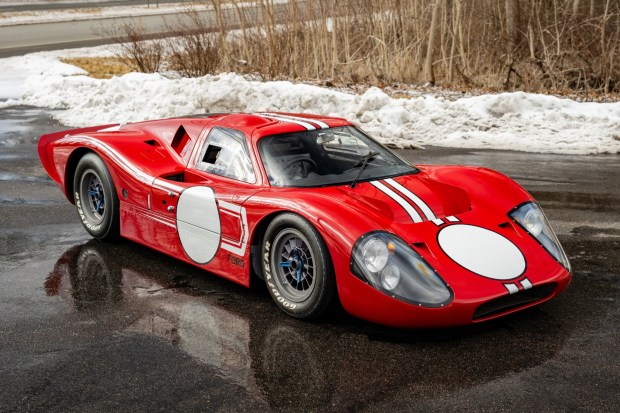
After four experimental chassis were built, four GT40s were fitted with Mark IV coupe bodywork developed by Shelby American Chief Engineer Phil Remington and accounted for victories in their only two starts at the 12 Hours of Sebring and the 24 Hours of Le Mans in 1967. Engine displacement restrictions devised for 1968 rendered the Mark IV J-cars ineligible for further Le Mans participation, causing Ford to retreat from the project with four chassis left unfinished.
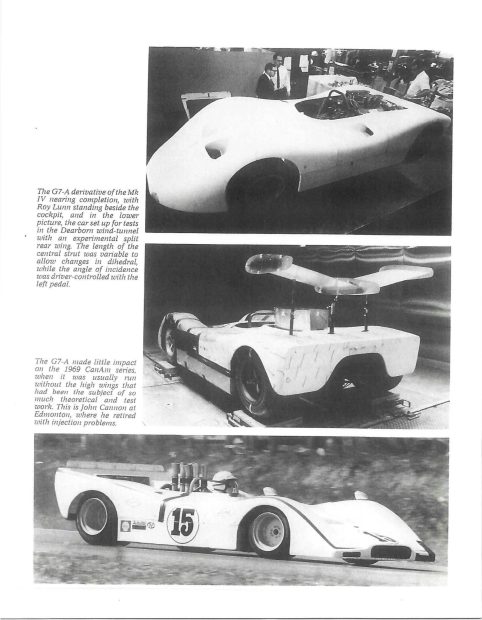
This example was initially fitted with a spyder body during development and testing by Ford before revised spyder bodywork was fitted during its racing career with the Agapiou brothers. According to 1996 correspondence from Kerry Agapiou, the section of the tub forward of the firewall was removed following damage in 1970 and was rebuilt with replacement panels prior to the sale of the chassis in 1989.
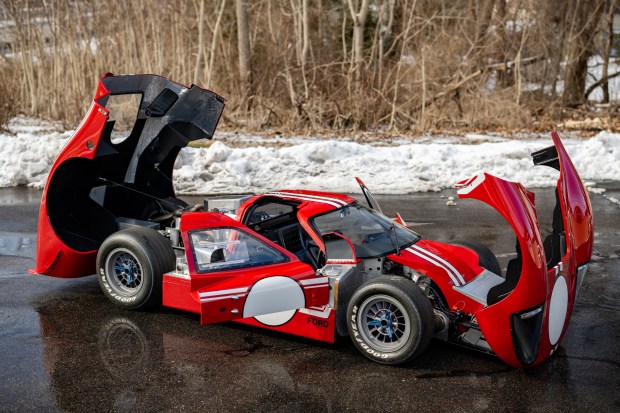
The current Mark IV-style body was fabricated under current ownership and features an aluminum roof structure integral to the chassis as well as a fiberglass nose panel, doors, and tail panel, the latter of which is hinged at the rear. The body is finished in a red and white livery replicating that worn by the 1967 Le Mans-winning Mark IV.
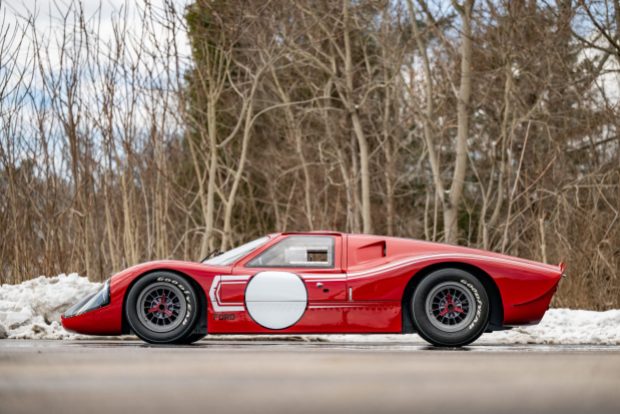
Turbine-style magnesium alloy wheels are secured by color-coded directional three-eared knock-offs and are wrapped in Hoosier TD S tires that measure 25.5×8.5-15 up front and 27.5×11.0-15 at the rear. White Goodyear lettering is overlayed on each tire. A spare housed under the tail panel wears Hoosier Vintage TD rubber. Stopping is handled by ventilated disc brakes with dual Wilwood master cylinders and front ducts that draw warmed air from behind the radiator.
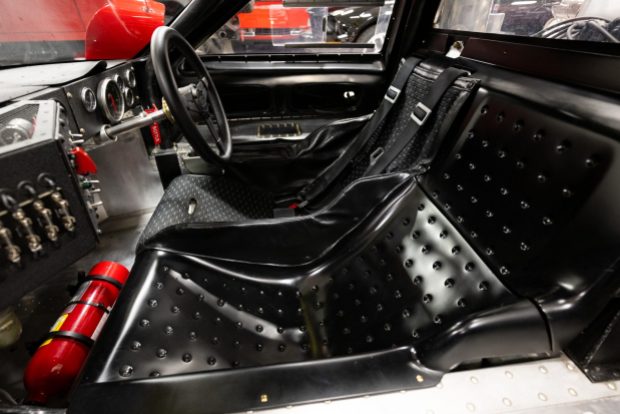
The right-hand-drive cockpit houses a driver’s seat trimmed in black cloth with vinyl bolster trim alongside an untrimmed dimpled passenger seat. Equipment includes a four-point latch-and-link driver’s harness, a steel roll cage, and a right-hand shifter with a wood knob. FIA regulations in the 1960s required that Le Mans entrants have an available passenger seat as well as covered accommodations for a suitcase as seen in this example’s engine bay.
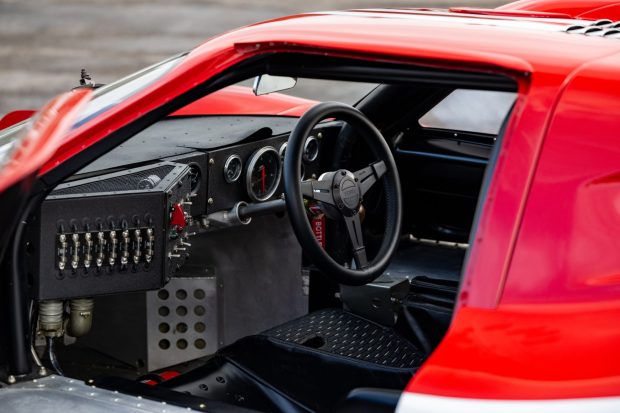
The three-spoke steering wheel sits ahead of a Jones Motrola tachometer as well as gauges monitoring coolant temperature, oil temperature, fuel pressure, and oil pressure. An array to the driver’s left hosts toggle switchgear and fuses. The car is not equipped with an odometer, and chassis mileage is unknown.
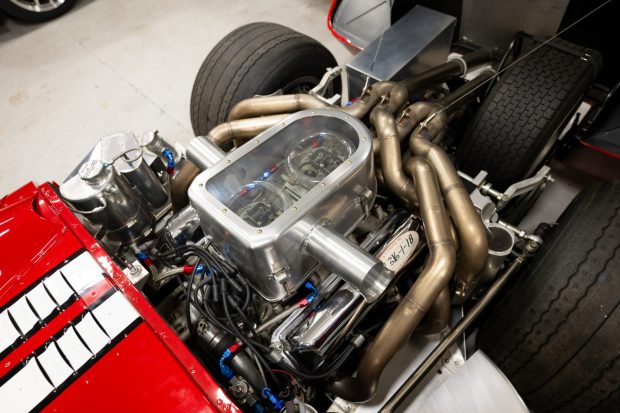
The chassis was outfitted with a variety of experimental powertrains during its time as a development vehicle with Ford and was fitted with its current 427ci Ford FE V8 during its conversion to Mark IV configuration. The engine features an iron block, aluminum tunnel-port cylinder heads, , a dual-port intake manifold, dual four-barrel Holley carburetors topped by clear velocity stacks and a cold air box, dry-sump lubrication, and “bundle of snakes” exhaust manifolds leading to dual exhaust outlets. Reproduction E & F Experimental Engine stickers are affixed to the valve covers. Cooling is handled by a front-mounted aluminum radiator with dual electric cooling fans and an oil cooler at the side of the engine bay.
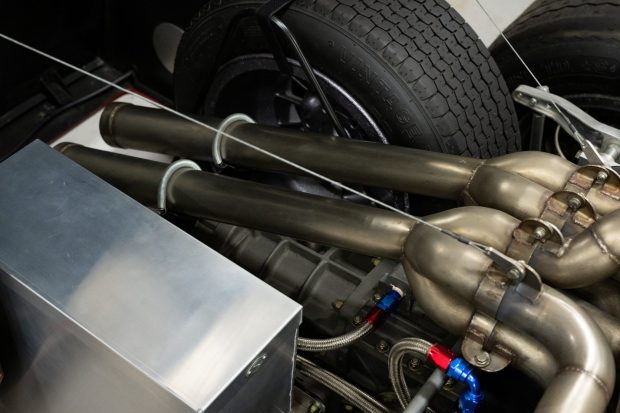
Power is sent to the rear wheels via Kar Kraft T-44 synchronized four-speed manual transaxle. Four-wheel independent suspension incorporates coilover shock absorbers and anti-roll bars at front and rear.
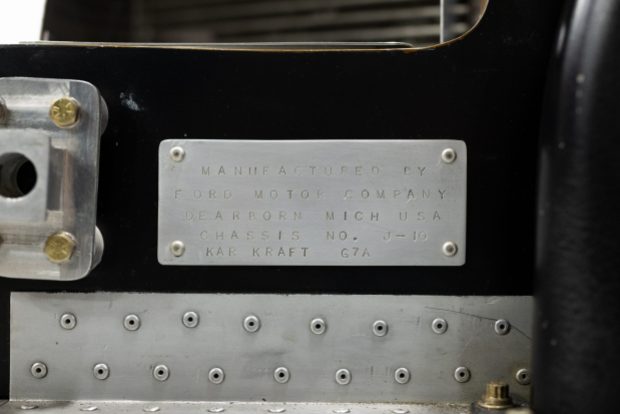
A tag affixed to the firewall inside the cockpit is stamped with chassis number J-10 as well as the G7A designation.
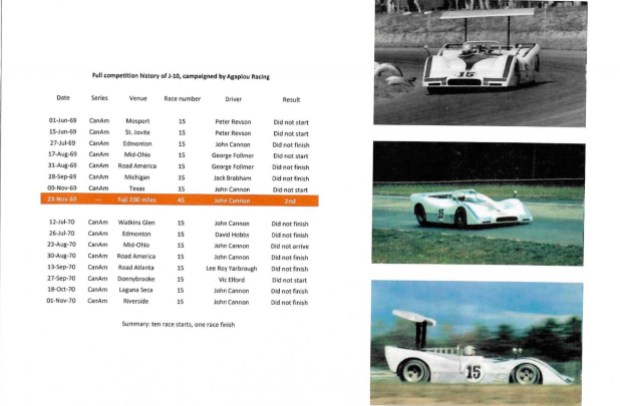
Photos of chassis J-10 during its Can-Am career are shown above along with a list of the car’s starts between 1969 and 1970, with drivers including Peter Revson, Jack Brabham, George Follmer, David Hobbs, Vic Elford, Lee Roy Yarbrough, and John Cannon, the latter of whom drove the car in its only finish. Additional pages of a summary of the car’s history are viewable in the photo gallery below.
The car is not legal for road use and carries no title or registration. It is being sold on a bill of sale.
You are not connected to real-time updates. Attempting to connect.
Your real-time updates could not be connected. Missed updates will be sent once your connection has been reestablished.
Your real-time updates could not be connected. Missed updates will be sent once your connection has been reestablished.
Your real-time updates could not be connected. Missed updates will be sent once your connection has been reestablished.
